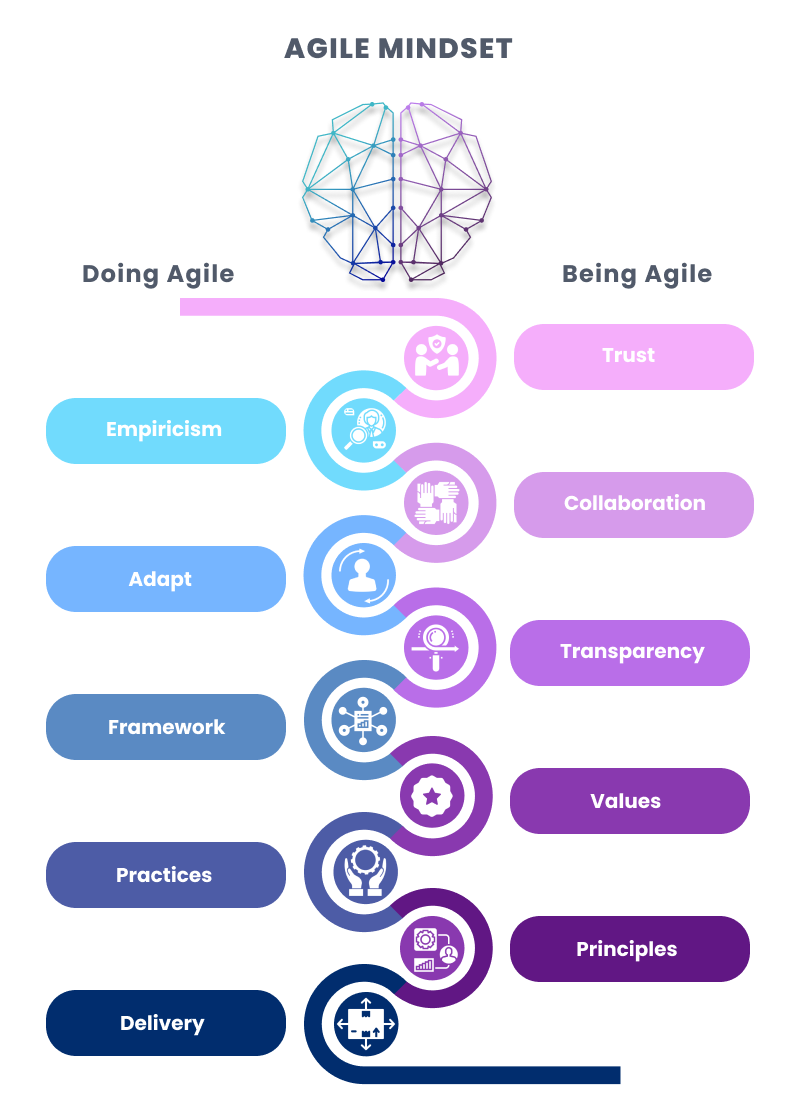
All the businesses that survive and thrive have one thing in common: the ability to be nimble. A successful business is business agile - it knows when to bend, pivot and change to accommodate forces by developing an Agile Environment. Business agility is adaptive, continuous, competitive, evolutionary and innovative in nature. And this is the step towards transformation.
In business environment, your market dynamics are often subject to quick changes since new technology inventions are sprouting up almost every day. As people start exploring better options, their demands change, expectations increase, and businesses must cope with them to ensure their long-term presence in the market. But how? Agility is the answer to this complex question.
Building an agile organization is the key to effectively manage all the change which, also, helps companies reduce their loss ratios.
![]() Agility is the ability to adapt and respond to change … agile organizations view change as an opportunity, not a threat.
Agility is the ability to adapt and respond to change … agile organizations view change as an opportunity, not a threat.
- Jim Highsmith![]()
Due to its flexibility, agile has become one of the most popular approaches to run organizations and manage projects today, irrespective of the industry. Over the last decade and a half, organizations have begun to see how agile is benefitting businesses all around the globe.
Stats and Findings on
According to a survey by Harvard Business Review, companies that provide an agile environment experience a 60% growth in revenue and profits. Another finding from Annual State of Agile Marketing Report -2020, 53% of Agile marketing teams can release things faster, and 51% can change gears quickly when feedback demands it.
As the agile framework is getting widely accepted by organizations, there are some noteworthy trends surveyed and complied by Annual State of Agile Report which goes like, Scrum is the most widely practiced Agile method framework. When surveyed at least 75% of respondents practicing Scrum or a hybrid that includes Scrum. SAFe® is again the scaling framework of choice, which leads with 35% of the respondents. (year surveyed - 2020)
As the support for agile adoption increases, people are looking for ways to develop an agile environment in their organizations so that they can enjoy its much-celebrated benefits. But before we discuss how to readily facilitate an effective agile environment in their workplace, let us look at the reasons why being agile is imperative for organizations. Here is the pronouncement for Agile Methodologies which every technology practitioner has imbibed within.
Manifesto for Agile Software Development
Individuals and Interactions over processes and tools
Working software over comprehensive documentation
Customer Collaboration over contract negotiation
Responding to change over following a plan
That is, while there is value in the items on the right, we value the items on the left more.
Why is agile environment important for your organization?
The importance of an agile environment for any organization is seen by its benefits, which makes it easier for Leaders to manage the change and execute a project in an effective manner. Let’s look at these benefits:
Enhanced quality products
Agile teams believe in regular testing of their products. With every testing, the flaws that come up are resolved immediately, and the product keeps getting finer. Your clients are also involved from Day 0, which ensures that the teams incorporate their feedback and improvements. This ensures Quality is never compromised and we can expect Quality to improve substantially.
Client satisfaction
It is an absolute must for agile organizations to keep their clients involved throughout the SDLC. Agile teams work with clients on defining the MVP – Involving them throughout gives the teams a chance to validate their understanding of the problem and ensure the team is working on what is needed right now. Client Feedback is important since they are the masters of their business and know how to navigate through the changing dynamics – Receiving feedback is one thing but acting on it gives confidence to the client that they have a say in how their investments are being handled. This leads to more satisfaction.
Leaders exercise better control
An essential feature of agile organizations is transparency which means that everyone in the organization knows what is happening, who is working on what, the feedback, corrective actions etc. Multiple reporting and analytics tools are also employed to remove the bottlenecks & improve the process with daily progress reports. As a result, Leaders can control the change more effectively and are able to take better decisions based on insightful data they gain on a regular basis.
Significant reduction in failures and risks
Agile methodology works by dividing projects into smaller chunks of work organized into sprints and releases. Idea is to work on the initial set of features, validate with the client to ensure the expectations are met and take corrective actions based on the feedback. This minimizes Risk to a large extent since you don’t have to wait for the entire project to be over before you get feedback. Continuous Testing is the core of any Agile team and this enables the Devs to take note of the Bugs / Defects and work on them immediately. As a result, the overall product is of a superior quality that significantly mitigates the risks for the organization.
High team morale
Enabling an environment where high performing teams come together is a sign of Agile maturity. With continuous testing, teams come with new solutions over how they can resolve an issue more effectively. Agile environment boosts communication and facilitates the cross-functional nature which ensures there is representation from all the different stakeholders. Teams are self-organized and often meet to discuss new ideas and challenges, while reporting about their statuses. Such organizations create a supportive, flexible, and growth-oriented environment for their teams, thus increasing the team morale and motivating them to perform better.
Benefits of an agile environment in organizations are multiple, which help business owners to optimize their productivity and exponentially improve their value creation process. Now that you clearly understand the importance of an agile environment for your organization, let’s look at how you can develop it.

How to develop an agile environment for your organization?
When you are aiming to bring Agility in your organization, there are several things you must keep in mind. Your priority should be to achieve customer satisfaction through continuous, on-time delivery of high-quality software. This includes accepting change as the only constant – always welcome them. You should, also, ensure your development and business teams stay in constant touch throughout the project, thus achieving better outcomes. If your Agile teams are working without direct involvement from your customer, then it is not Agile – You are practicing Quasi-Agile. These factors are essential before you begin to develop an agile environment for your organization.
Ask relevant questions
Always ask yourself “Why?” Is it because of the benefits? Or because you believe there is a gap in what your customer expects, and your teams deliver? It is important to note that Agile mindset brings in the necessary change for the old ways of building software to pave to new ways. Once you are aware of the “Why” it becomes easier to proceed towards “How.” A lot of new ideas can be generated during this step, and a lot of clarity can also be achieved. It will help you to pinpoint the compelling reason for this transformation and help you work towards it.
Build a team
The most crucial step is to build the right team. People are the first and foremost step for any transformation to take effect from the grounds up. Look at your current set of people, identify the gaps, give them a platform to reskill / upskill and then form the core team around which you will bring in more people. Your core team needs to understand the why’s and what’s and ensure that they work towards minimizing the risks.
Create achievable goals
Goals should be SMART i.e., Specific, Measurable, Attainable, Relevant and Time-based. So, instead of giving vague instructions, formulate documents with well explained, achievable goals so that your team members can effectively work converting those goals into reality. You must come up with ways to achieve the best results possible with minimal resources – More for less aka Lean Thinking. These goals must clarify your priorities–whether it is quality, or speed, or both and these must be clear to your team members before the actual work begins.
Create effective communication channels
Communication is very crucial for driving Agile transformation. It is important that you create proper communication channels with your team members. This includes not only telling them about your priorities but also listening to their suggestions and implementing the feedback. This gives them a sense of ownership and accountability. Remember, communication does wonders.
Focus on delivering immediate value
By breaking down your project into small, tangible chunks will help you to improve your team’s morale while providing assurance to your management and rest of the organization. Your primary focus should be on delivering value to your stakeholders. Agile environment enables the teams to deliver smaller chunks of work to keep your customer happy and satisfied. These small wins create a positive environment that will recharge your SDLC process.
Establish a learning environment
When you begin any new project, challenges, and issues surface. Especially when the project is critical to your success, it is important to focus not only on incremental deliveries but also on the learning from small failures. Such learnings will help your team gain more knowledge and speed up the value creation process. It will give your team members a sense of ownership of their actions while increasing their knowledge base for any upcoming problems.
Organizations with agile environment focus on delivering high quality products and value to clients faster. It helps them to optimize their costs and mitigate risks. If you are thinking about How to move the needle from “Doing Agile to Being Agile” or want to bring in Agility in your day-to-day operations, our team of Agilists can help you. Write to us at info@qentelli.com

